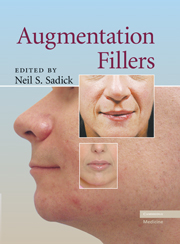Book contents
- Frontmatter
- Contents
- LIST OF CONTRIBUTORS
- Ch. 1 Application of Fillers
- Ch. 2 Approach to Choosing the Ideal Filler
- Ch. 3 Patient Selection, Counseling, and Informed Consent
- Ch. 4 Hyaluronic Acid Skin Derivatives
- Ch. 5 Collagen Products
- Ch. 6 Radiesse
- Ch. 7 ArteFill
- Ch. 8 Augmentation Fillers in Cosmetic Dermatology: Silicone
- Ch. 9 Advanta Expanded Polytetrafluoroethylene Implants
- Ch. 10 Sculptra
- Ch. 11 Lipo Transfer
- Ch. 12 BioAlcamid®
- Ch. 13 Combination of Approaches in Augmentation Fillers in Cosmetic Dermatology
- Ch. 14 Filling Complications
- Ch. 15 Postprocedure Management and Patient Instructions
- Ch. 16 Conclusion: Future Trends in Fillers
- INDEX
- References
Ch. 13 - Combination of Approaches in Augmentation Fillers in Cosmetic Dermatology
Published online by Cambridge University Press: 26 February 2010
- Frontmatter
- Contents
- LIST OF CONTRIBUTORS
- Ch. 1 Application of Fillers
- Ch. 2 Approach to Choosing the Ideal Filler
- Ch. 3 Patient Selection, Counseling, and Informed Consent
- Ch. 4 Hyaluronic Acid Skin Derivatives
- Ch. 5 Collagen Products
- Ch. 6 Radiesse
- Ch. 7 ArteFill
- Ch. 8 Augmentation Fillers in Cosmetic Dermatology: Silicone
- Ch. 9 Advanta Expanded Polytetrafluoroethylene Implants
- Ch. 10 Sculptra
- Ch. 11 Lipo Transfer
- Ch. 12 BioAlcamid®
- Ch. 13 Combination of Approaches in Augmentation Fillers in Cosmetic Dermatology
- Ch. 14 Filling Complications
- Ch. 15 Postprocedure Management and Patient Instructions
- Ch. 16 Conclusion: Future Trends in Fillers
- INDEX
- References
Summary
INTRODUCTION
Dermal filling agents and botulinum neurotoxin are currently widely utilized for facial augmentation and global restoration of the aging face. For years, the conventional wisdom regarding dermal injectables for facial rejuvenation was “Botox for the upper face; Fillers for the lower face.” However, cosmetic dermatologists have advanced from the practice of treating single lines and wrinkles toward filling large facial areas to globally restoring natural facial contours (Ditre, 2008). Cosmetic dermatologists now have a better understanding of the facial aging process, and as new fillers become available, there is an increased recognition that when treating the aging face, the combination of soft tissue augmentation and botulinum toxin takes part in principal roles to fill, lift, tighten, and relax rhytids.
OVERVIEW OF INJECTABLE DERMAL FILLERS
Over the last four years, the US Food and Drug Administration (FDA) has approved many dermal filling agents. European countries and South America have had numerous dermal filling agents available for several years. Therefore, it can be quite difficult to decide what filler to use and where the filler should be injected. Injectable dermal fillers can be grouped according to their degree of degradability. In general, fillers may be classified into biodegradable and nonbiodegradable products. The degradable material may be further classified into xenografts (derived from another species such as bovine collagen or hyaluronic acid of bacterial or avian origin), autografts (from the same person, such as autologous fat), and synthetic products (PLLA and CaHA) (Jones, 2007, p. 106).
- Type
- Chapter
- Information
- Augmentation Fillers , pp. 117 - 128Publisher: Cambridge University PressPrint publication year: 2010



